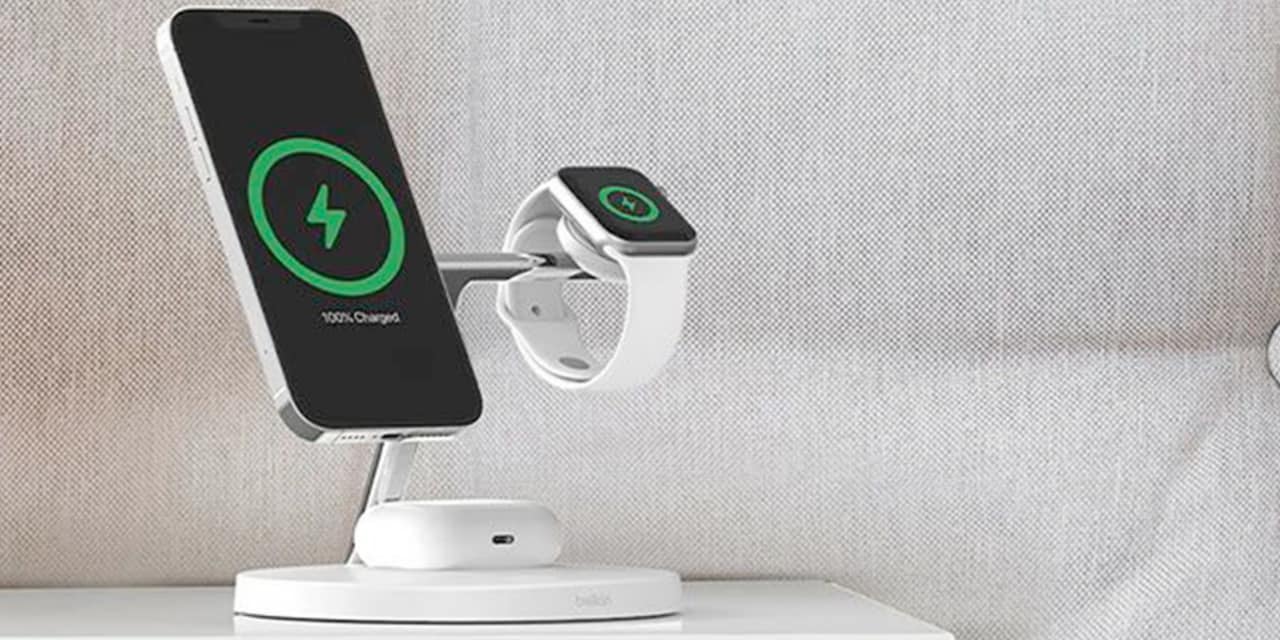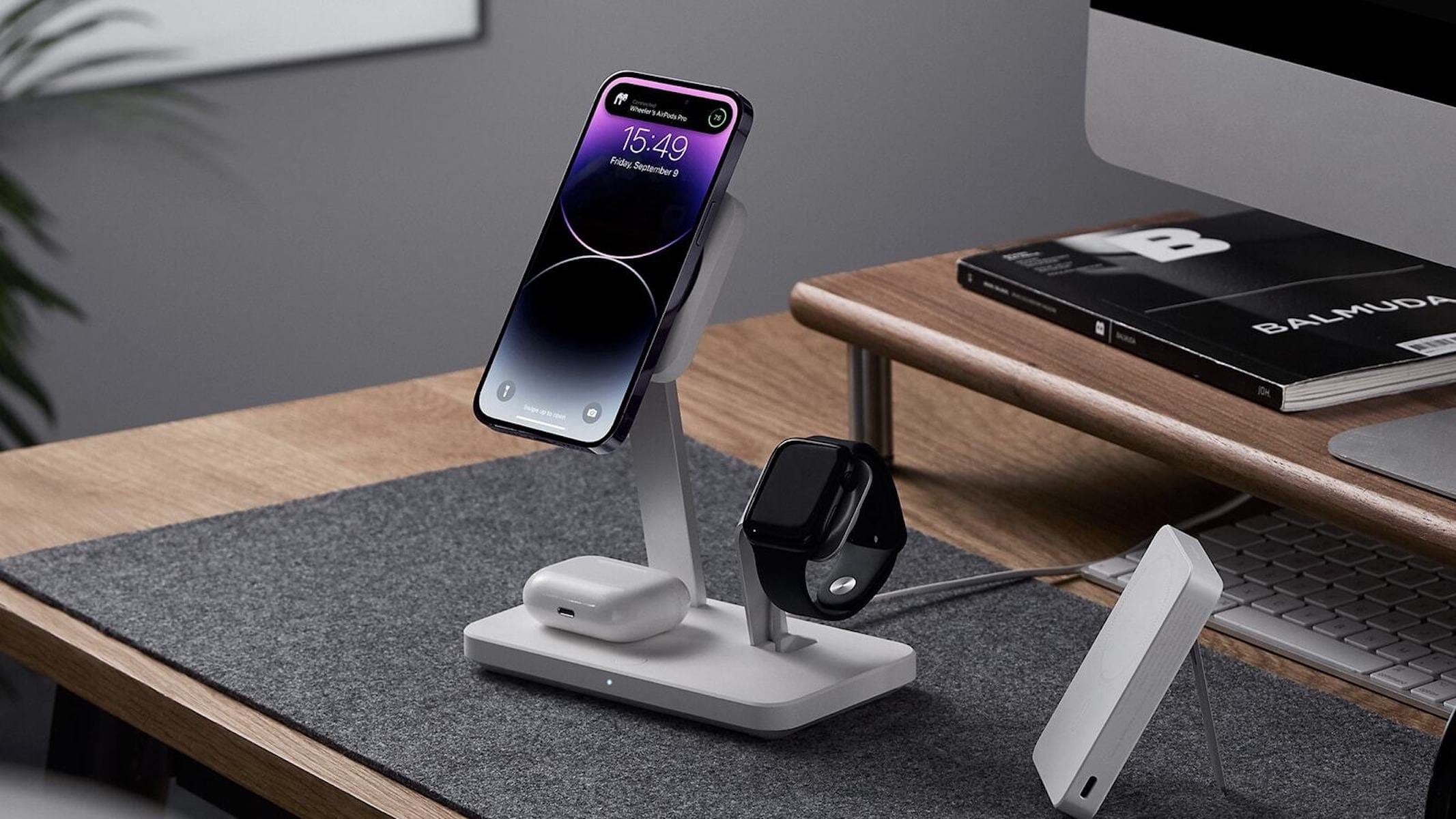Anúncios
As technology evolves, so too does the way we interact with our devices. The era of tangled cables and multiple chargers is becoming a thing of the past. The future is here, and it’s wireless. Welcome to the age of wireless charging gadgets that promise ultimate convenience and efficiency.
Imagine a world where your smartphone, laptop, smartwatch, and even electric toothbrush recharge simultaneously on a single pad, without a single cable in sight. A world where ‘battery low’ notifications are no longer a source of anxiety, and where you no longer need to rummage through drawers looking for that elusive charger. This isn’t a vision of a distant future; it’s a reality that’s already within our grasp.
Anúncios
In this enlightening read, we will delve into the world of wireless charging technology, exploring the benefits it holds for everyday life and business operations. We will look at the latest innovations, understand how they work, and uncover what the future may hold for this game-changing technology.
Join us as we cut the cord and embrace the future with wireless charging gadgets. Say goodbye to clutter and hello to convenience, efficiency, and an entirely new way of powering your life. Get ready to revolutionize the way you charge!
Anúncios
Understanding Wireless Charging
Wireless charging technology is not entirely new. However, it’s rapidly gaining traction due to the convenience and efficiency it offers, especially in an increasingly mobile and interconnected world. This technology allows for the charging of devices without the need for physical cables or plugs, reducing clutter and enhancing user experience. Instead, it relies on a power-transmitting pad and a compatible device that must be in direct contact with or very close to the pad to initiate charging.
The underlying science behind this method is based on electromagnetic induction, a principle discovered in the 19th century. A charging station, or transmitter, generates an alternating electromagnetic field using a coil. When a compatible device, or receiver, equipped with its own coil, is placed on or near the pad, it receives this energy through inductive coupling. The receiver coil converts the electromagnetic energy into electrical current, which then charges the device’s battery.
This process is not only safe but also smart. Many modern wireless charging systems include built-in safety features, such as temperature control, foreign object detection, and automatic shutoff once the battery is fully charged. These features help prevent overheating, energy waste, and potential hazards.
Wireless charging is also more durable in the long run. By eliminating the need for constant plugging and unplugging, it reduces wear and tear on charging ports—a common failure point in many devices. This translates to a longer lifespan for your gadgets and fewer trips to the repair shop.
Additionally, as charging standards like Qi (pronounced “chee”) become more universal, interoperability between different brands and devices has improved significantly. This means users can rely on a single charging pad for multiple devices, from phones and earbuds to smartwatches and even electric toothbrushes, enhancing both convenience and sustainability.
The Benefits of Wireless Charging
One of the most obvious benefits is the convenience factor. With wireless charging, there’s no need to plug and unplug every time you need to use your device. Simply placing your device on the pad will start charging it up. Plus, it’s a more universal solution. As long as a device is compatible with the charging station, it will charge, regardless of the model or brand.
Another benefit is the reduced wear and tear on device ports. Constant plugging and unplugging can cause significant damage over time, leading to loose connections or broken ports. With wireless charging, this is no longer a concern.
Wireless Charging Gadgets
The market is filled with numerous wireless charging gadgets, ranging from those designed for smartphones, tablets, and wearable devices to larger ones meant for laptops and electric cars.

Wireless Chargers for Smartphones and Tablets
For smartphones and tablets, there are many options available. For instance, the Anker Wireless Charging Pad offers fast charging speeds and broad compatibility, making it a popular choice.
- Belkin Boost Up Wireless Charging Pad
- Yootech Wireless Charger
- Samsung Wireless Fast Charger
Wireless Chargers for Laptops
Laptops have traditionally lagged behind smartphones and wearables in the adoption of wireless charging technology, primarily due to their higher power requirements. However, this gap is beginning to close as new innovations emerge to bring wireless charging to larger, more power-hungry devices. As we move toward a truly wireless ecosystem, the ability to charge laptops without cumbersome cords is no longer just a futuristic concept—it’s slowly becoming a reality.
One of the pioneering devices in this space is the Dell Latitude 7285, which made headlines as one of the first laptops to support wireless charging. The Latitude 7285 achieves this through a combination of a detachable 2-in-1 tablet and a compatible charging mat. When the device is connected to its keyboard base and placed on the mat, it charges without the need for a traditional power cable. While this system is proprietary and not yet mainstream, it showcases the potential of integrating wireless power into portable computing.
Another promising development comes from companies like Wi-Charge, which are pushing the boundaries of wireless energy transfer. Their Long-Range Wireless Power Transmitter uses infrared beams to deliver power to compatible receivers over several meters. This technology, still in early commercial stages, promises to one day power laptops and other mid-power devices from across the room—no cables or pads required. The key advantage of this system is its ability to charge devices while they are in use and in motion, paving the way for truly seamless, continuous power delivery.
Beyond these high-end innovations, the market is also seeing growth in universal wireless charging pads with support for USB-C or magnetic receivers. While these aren’t yet as efficient or fast as plug-in charging, they offer a bridge between current tech and the wireless future. For example, accessories like Magnetic Wireless Charging Cases or USB-C-compatible wireless adapters can enable laptops without native support to benefit from wireless charging—though typically at slower speeds and with limitations on positioning.
The Challenges and Progress
There are technical and practical challenges that have slowed the widespread adoption of wireless charging for laptops. First and foremost is power delivery. Most laptops require 45W to 100W or more for effective charging, while most wireless charging pads today provide only 10W to 20W. Efficiency is also an issue: wireless charging is typically less efficient than wired, leading to longer charging times and more energy loss as heat.
However, engineers and tech companies are working diligently to overcome these limitations. Advancements in resonant inductive coupling, higher frequency coils, and more efficient receivers are being developed to make wireless laptop charging more practical. Some companies are exploring desktop surfaces with built-in wireless charging zones, so users can simply place their laptop on the desk to begin charging—no cables, no setup, just instant power.
What to Expect in the Near Future
We can expect to see more hybrid solutions emerge in the coming years. These might include charging docks, charging sleeves, or modular charging mats that combine magnetic alignment with higher power output, making wireless laptop charging more accessible to consumers and businesses alike. As demand increases, manufacturers are likely to adopt unified standards, just as smartphones have with the Qi protocol.
Enterprise adoption could also play a major role in this evolution. In workplaces, shared spaces, and co-working environments, wireless power stations for laptops could reduce cable clutter and create more flexible, collaborative spaces. Airports, hotels, and universities may also integrate such solutions as part of their infrastructure to support mobile workforces and students.
Adopting Wireless Charging in Everyday Life
Adopting wireless charging in everyday life is not just about convenience, but also about embracing a future without the clutter of wires. It’s about reducing the number of cables you need to carry when travelling, or the number of chargers plugged into your power strip at home.

Wireless Charging in Public Spaces
The proliferation of wireless charging technology is not just confined to our homes and offices. Many public spaces like restaurants, cafes, airports, and hotels are now providing wireless charging pads for public use. This not only offers a convenient way for people to charge their devices, but also adds to the appeal of these establishments.
Wireless Charging in Vehicles
The automotive industry is not far behind in adopting this technology. Many new models of cars are now equipped with built-in wireless charging pads, providing a convenient way for passengers to charge their devices on the go.
Future of Wireless Charging
The future of wireless charging looks incredibly promising, with breakthroughs on the horizon that aim to overcome the current limitations of proximity, efficiency, and speed. As technology continues to evolve, we can expect wireless charging to become faster, more versatile, and increasingly integrated into our everyday environments—from homes and workplaces to vehicles and public infrastructure.
One of the most anticipated advancements is the refinement of resonant inductive coupling. Unlike traditional inductive charging, which requires close alignment and contact with the charging pad, resonant systems can transmit power over greater distances and through surfaces like wood or plastic. This opens the door to furniture-integrated charging—imagine placing your laptop or phone anywhere on your desk or nightstand, and it charges automatically without the need for precise positioning.
Another emerging technology is RF (radio frequency) and infrared wireless charging, which promises truly contactless power delivery. Companies like Ossia and Wi-Charge are pioneering solutions that can send power across several meters, enabling devices to charge while in use or in motion. This could revolutionize not only consumer electronics but also industrial applications, smart homes, and medical wearables, where constant cable-free charging would be invaluable.
Additionally, the development of smart charging networks powered by AI could allow devices to communicate with chargers to optimize energy transfer based on usage patterns, battery health, and grid availability. This would not only improve charging efficiency but also align with broader sustainability goals by reducing wasted energy.
In the not-so-distant future, we may witness a world where cables are completely obsolete, and wireless energy is as ubiquitous as Wi-Fi. With continued investment and innovation, wireless charging is poised to become a foundational element of the modern digital lifestyle—seamless, invisible, and always on.
Advancements in Wireless Charging Technology
While current wireless charging technology requires close proximity, future advancements could allow for charging over larger distances. Companies like Wi-Charge are already working on this, aiming to create a truly wireless future where devices can be charged from across the room.
Integration with Internet of Things (IoT)
With the rise of smart homes and the Internet of Things (IoT), wireless charging could play a key role in powering our connected devices. Imagine a future where your smartwatch charges as you sleep, your phone charges as you work at your desk, and your electric car charges in your garage—all without the need for a single cable.
In conclusion, it’s evident that we’re standing on the brink of a wireless charging revolution, signifying an epoch of unrivaled convenience and efficiency. The days of messy cables and the constant hassle of plugging and unplugging devices will soon be an antiquated concept. The advent of wireless charging gadgets, from smartphones to electric vehicles, is not just a trend, but an undeniably crucial step towards our high-tech future.
As we continue to embrace this wireless future, the perks are unequivocal. Not only does it provide ultimate convenience, but it also significantly enhances efficiency, making our lives more seamless and less cluttered. Moreover, wireless charging technology is rapidly improving, promising faster charging times and extended battery life.
Cutting the cord is no longer a mere option, but rather an essential progression. It’s time to let go of outdated practices and welcome the ease and sophistication that wireless charging gadgets bring. So, are you ready to cut the cord and embrace the future? Remember, it’s not just about staying up-to-date with technology trends, but also about simplifying your life for the better. Wireless charging is here to stay, and its future is looking brighter than ever.
Conclusion
In a world where innovation is accelerating like never before, technology is not just evolving—it’s enhancing the way we live, monitor our health, and interact with the devices around us. From fitness trackers that guide us toward healthier habits to smartwatches, glucose monitors, sleep aids, and UV sanitizers, health and wellness gadgets have empowered individuals to take proactive control of their bodies and minds.
At the same time, the rise of wireless charging technology is transforming our daily routines—eliminating cable clutter, increasing efficiency, and pointing us toward a truly wireless lifestyle. Whether at home, at work, or on the move, we now have the tools to stay charged, connected, and well—without sacrificing convenience or performance.
What ties all these innovations together is their ability to integrate seamlessly into our routines, helping us lead smarter, healthier, and more efficient lives. They represent a future in which technology adapts to us, not the other way around. And as wireless energy advances, and health-monitoring devices become more intelligent and accessible, we are witnessing a powerful shift—one that blends well-being, productivity, and digital freedom.
Ultimately, embracing these technologies isn’t just about staying current; it’s about investing in a better quality of life. So whether you’re optimizing your health, simplifying how you charge your devices, or both, one thing is clear: the future is here—and it’s both connected and cable-free.
Now is the time to take charge—of your health, your energy, and your future.

